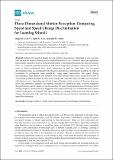Files in this item
Three-dimensional motion perception : comparing speed and speed change discrimination for looming stimuli
Item metadata
| dc.contributor.author | Lee, Abigail Rachael Ingle | |
| dc.contributor.author | Ales, Justin Michael | |
| dc.contributor.author | Harris, Julie | |
| dc.date.accessioned | 2020-07-06T13:30:02Z | |
| dc.date.available | 2020-07-06T13:30:02Z | |
| dc.date.issued | 2020-07-06 | |
| dc.identifier | 268760015 | |
| dc.identifier | c3399c6f-a906-48ab-a1ea-a57d7af71ae3 | |
| dc.identifier | 85090664001 | |
| dc.identifier.citation | Lee , A R I , Ales , J M & Harris , J 2020 , ' Three-dimensional motion perception : comparing speed and speed change discrimination for looming stimuli ' , Vision , vol. 4 , no. 3 , 33 . https://doi.org/10.3390/vision4030033 | en |
| dc.identifier.issn | 2411-5150 | |
| dc.identifier.other | ORCID: /0000-0002-3497-4503/work/77131139 | |
| dc.identifier.other | ORCID: /0000-0002-5052-1029/work/77131759 | |
| dc.identifier.uri | https://hdl.handle.net/10023/20211 | |
| dc.description | Funding: This work was supported by the Biotechnology and Biological Sciences Research Council (BBSRC; https://bbsrc.ukri.org/) [grant number BB/M010996/1 to A.R.I.L., BB/N018516/1 to J.M.A.and BB/M001660/1 to J.M.H.]. | en |
| dc.description.abstract | Judging the speed of objects moving in three dimensions is important in our everyday lives because we interact with objects in a three-dimensional world. However, speed perception has been seldom studied for motion in depth, particularly when using monocular cues such as looming. Here, we compared speed discrimination, and speed change discrimination, for looming stimuli, in order to better understand what visual information is used for these tasks. For the speed discrimination task, we manipulated the distance and duration information available, in order to investigate if participants were specifically using speed information. For speed change discrimination, total distance and duration were held constant; hence, they could not be used to successfully perform that task. For the speed change discrimination task, our data were consistent with observers not responding specifically to speed changes within an interval. Instead, they may have used alternative, arguably less optimal, strategies to complete the task. Evidence suggested that participants used a variety of cues to complete the speed discrimination task, not always solely relying on speed. Further, our data suggested that participants may have switched between cues on a trial to trial basis. We conclude that speed changes in looming stimuli were not used in a speed change discrimination task, and that naïve participants may not always exclusively use speed for speed discrimination. | |
| dc.format.extent | 17 | |
| dc.format.extent | 742418 | |
| dc.language.iso | eng | |
| dc.relation.ispartof | Vision | en |
| dc.subject | Looming | en |
| dc.subject | Motion in depth | en |
| dc.subject | Speed discrimination | en |
| dc.subject | Speed change discrimination | en |
| dc.subject | BF Psychology | en |
| dc.subject | RC0321 Neuroscience. Biological psychiatry. Neuropsychiatry | en |
| dc.subject | DAS | en |
| dc.subject.lcc | BF | en |
| dc.subject.lcc | RC0321 | en |
| dc.title | Three-dimensional motion perception : comparing speed and speed change discrimination for looming stimuli | en |
| dc.type | Journal article | en |
| dc.contributor.sponsor | BBSRC | en |
| dc.contributor.sponsor | BBSRC | en |
| dc.contributor.institution | University of St Andrews. School of Psychology and Neuroscience | en |
| dc.contributor.institution | University of St Andrews. Institute of Behavioural and Neural Sciences | en |
| dc.identifier.doi | https://doi.org/10.3390/vision4030033 | |
| dc.description.status | Peer reviewed | en |
| dc.identifier.url | https://www.mdpi.com/2411-5150/4/3/33 | en |
| dc.identifier.grantnumber | BB/N018516/1 | en |
| dc.identifier.grantnumber | BB/M001660/1 | en |
This item appears in the following Collection(s)
Items in the St Andrews Research Repository are protected by copyright, with all rights reserved, unless otherwise indicated.

